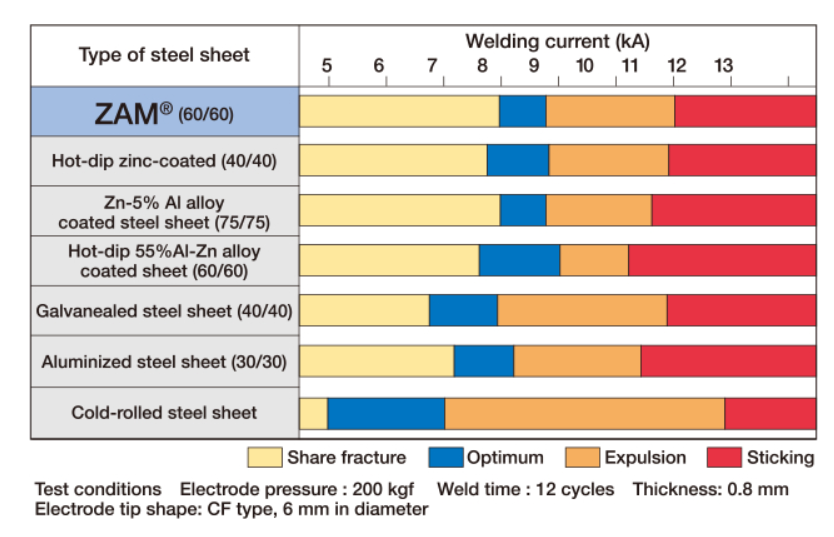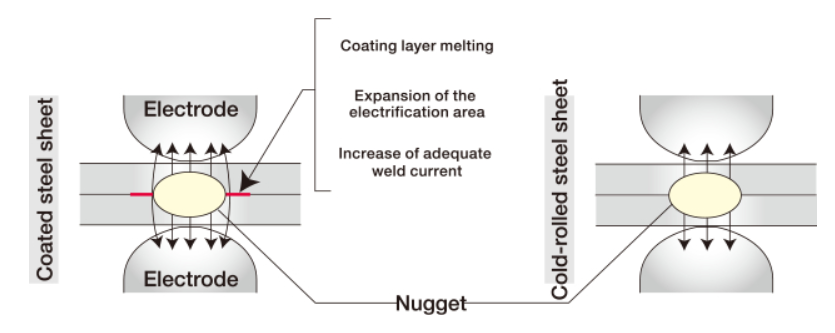As with other zinc-based coated steel sheets, weldability of ZAM® is affected by its coating layer
which is a metal with a low melting point. In arc welding, ZAM® is more susceptible to spatters, blow holes,
crack-induced decline in joint strength and other defects than hot-rolled and cold-rolled steel sheets.
However, ZAM® can be welded into joints with adequate strength under proper conditions.
Even in spot welding, adequate strength can be obtained under proper conditions.
Since factors including types of welding machines and shapes of joints influence the quality of welds,
tests should be carried out beforehand to establish optimal welding parameters and procedures.
Further technical information on welding is available upon request.
If you want it, contact the department in charge of our company.
*In arc welding, high tensile stress may be caused around the weld beads depending on shapes and compositions of materials and procedures. When zinc coated steel sheets including ZAM® are welded, coating layer melted by the heat of welding may penetrate the grain boundary and cause cracks in the zones affected by such high tensile stress.
Arc welding
1. Welding machine
ZAM® can be welded with a off-the-shelf welding machine. Welding environment can be improved with the use of invertercontrolled welding machines developed by equipment manufacturers to reduce spatters.
2. Welding wire
Welding wires for carbon steel and structural steel can be used. However, to reduce spatters, blow holes, pits, and other defects, it is advisable to use welding wires developed specially for galvanized steel. Recommended wires are shown on the right.
3. Shielding gas
The third-class carbon dioxide stipulated in JIS K 1106 is used. (The combination of pulse current and Ar+20% CO2 gas will tend to decrease spatters to a greater extent.)
4. Welding current and voltage
When welding ZAM® at the same speed as in the case of hot- or cold-rolled steel sheets, the initial welding temperature should be set slightly higher as more heat is absorbed by the evaporation of coating material (current to be raised by 5%-10%).
5. Welding speed
When such defects as blowholes or pits are found, the welding speed should be set lower than in the case of hot- or coldrolled steel sheets. Good beads can be made if weld speed is slow enough to release zinc vapor from the surface of the molten metal pool.
6. Installation of gaps
Lap fillet welding tends to cause such defects as blowholes or pits frequently. The most effective countermeasure is to set up gaps between steel sheets. A gap of 0.6 mm or wider helps substantially reduce these defects
Recommended welding wires for class 400N substrates
| Recommended welding wire brand (shielding gas: Carbon dioxide) | |
|---|---|
| General-purpose wire | Kobe Steel: MG50T, Nippon Steel Welding & Engineering Co., Ltd.: YM28, Daido Steel: DS1A, etc. (equivalent to YGW12) |
| Wire for coated steel sheets | Kobe Steel: MG1Z (G49A0C12), Nippon Steel Welding & Engineering Co., Ltd.: YM28Z (G49A0C0) |
| Flux-cored wire | Kobe Steel: DW-Z100 (T49J0TI-ICA-U), Neis: GC 2Z-2, etc., Nippon Steel Welding & Engineering Co., Ltd.: SM-1 (T49J0T15-0CA-G-UH5), SM-1F (T49J0TI-0CA-UH5), |
Examples of gaps for blowhole countermeasures (lap-fillet welded joint)
Decrease of welding defects with gaps
Spot welding
When a coated steel sheet is spotwelded, the energizing path expands due to melting of the coating layer, resulting in a decrease in electric current density. It is therefore necessary to use a greater welding current than in the case of cold-rolled steel sheets.
The zinc contained in the coating layer reacts with the copper alloy used for the electrodes, which causes the electrodes to wear rapidly, shortening their life. For this reason, grasp the l i fe of the electrodes in advance and periodically dress or replace them.
Examples of spot welding conditions for various types of coated steel sheets
Spot welding of coated steel sheet (schematic)
Quality of welds
To obtain defect-free joints with sufficient weld strength and a desirable internal sectional structure, it is essential to conduct welding under appropriate conditions.

Photos of bead appearances

Sputter and other problems can be prevented by conducing under appropriate conditions.
Source: Nippon Steel







